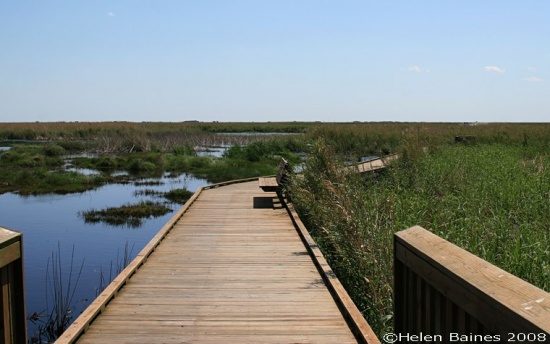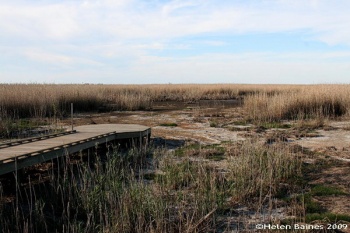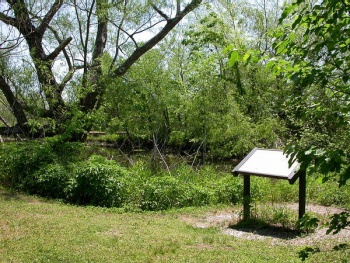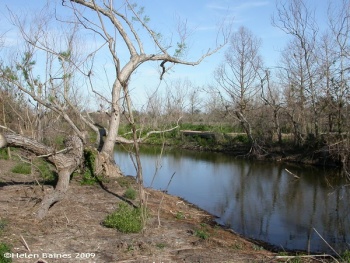m (typo) |
|||
| Line 54: | Line 54: | ||
[[Image:The Willows after Ike.jpg|thumb|350px|right|Photo by {{user|HelenB|HelenB}}<br/>The Willows in April 2009, 7 months after Hurricane Ike devastated the Refuge. This area has not recovered completely as the willows and bald cypresses were killed by the saltwater storm surge]] | [[Image:The Willows after Ike.jpg|thumb|350px|right|Photo by {{user|HelenB|HelenB}}<br/>The Willows in April 2009, 7 months after Hurricane Ike devastated the Refuge. This area has not recovered completely as the willows and bald cypresses were killed by the saltwater storm surge]] | ||
For a PDF map of the Refuge, go to this page on the FWS website: [http://www.fws.gov/uploadedFiles/anahuac%20fact%20sheet%20map%202006%281%29.pdf#b] | For a PDF map of the Refuge, go to this page on the FWS website: [http://www.fws.gov/uploadedFiles/anahuac%20fact%20sheet%20map%202006%281%29.pdf#b] | ||
| − | *The Willows, near the beginning of the auto tour loop | + | *The Willows, near the beginning of the auto tour loop was a good migrant trap in the spring, for warblers, tanagers and vireos, but it was extensively damaged in the hurricane. The saltwater of the storm surge killed the willows and bald cypresses, so this area will take a long time to recover. However, the dead trees are attracting woodpeckers as a bonus. |
| + | *The Jackson Woodlot (formerly known as the Salt Cedars) is proving to be a good migrant trap. It is the only group of trees on the Frozen Point road. The new bird blind has been built here. | ||
*The Shoveler Pond auto tour loop is 2.5 miles in length. There is a 750' boardwalk on the west side of Shoveler Pond, which is built of wildlife-friendly recycled plastic. View species such as [[Least Bittern]] or [[Marsh Wren]] from the viewing platform. This freshwater pond was devastated by the saltwater storm surge during the hurricane, but is recovering after a few wet winters. | *The Shoveler Pond auto tour loop is 2.5 miles in length. There is a 750' boardwalk on the west side of Shoveler Pond, which is built of wildlife-friendly recycled plastic. View species such as [[Least Bittern]] or [[Marsh Wren]] from the viewing platform. This freshwater pond was devastated by the saltwater storm surge during the hurricane, but is recovering after a few wet winters. | ||
*Skillern (East Bay Bayou) Tract - '''NOTE:''' The Skillern (East Bay Bayou) tract is located seven miles east of the main entrance on FM 1985. The entrance road to this 300 acre tract runs through rice fields and moist soil units, which support shorebirds, wading birds and waterfowl. [http://www.fws.gov/uploadedFiles/Skillern%20fact%20sheet%20map%202006%281%29.pdf#c PDF map of Skillern Tract] | *Skillern (East Bay Bayou) Tract - '''NOTE:''' The Skillern (East Bay Bayou) tract is located seven miles east of the main entrance on FM 1985. The entrance road to this 300 acre tract runs through rice fields and moist soil units, which support shorebirds, wading birds and waterfowl. [http://www.fws.gov/uploadedFiles/Skillern%20fact%20sheet%20map%202006%281%29.pdf#c PDF map of Skillern Tract] | ||
Revision as of 23:12, 28 February 2013

The boardwalk at Shoveler Pond in April 2008. The area has recovered well since the Hurricane Ike storm surge devasted the refuge in Sept. 2008, but it does look different to this photo taken earlier in 2008
Overview
A national wildlife refuge, over 34,000 acres in size, consisting mainly of coastal marsh, coastal prairie and coastal woodlands. It is part of the Texas Chenier Plain National Wildlife Refuge Complex, which embraces more than 100,000 acres from the Louisiana border to Galveston Bay. Anahuac NWR is located on East Galveston Bay, approximately 1.5 hours drive, east of Houston.
Anahuac NWR is site UTC 49 on the Great Texas Coastal Birding Trail. The Skillern (East Bay Bayou) Tract, 7 miles to the east, is site UTC 50.
NOTE: Anahuac NWR is celebrating its 50th Birthday in 2013. Check out the Friends of Anahuac website (see External Links1) for events going on throughout the year.
Birds
Notable Species
318 species of birds have been recorded at Anahuac NWR. Six rail species are there: Clapper Rail, King Rail and Virginia Rail, and Sora. Black Rail is present, but very rare. Yellow Rail are there, too, but almost impossible to see. Best chance is to join the Christmas Bird Count and ride the "swamp buggy", or sign up for a Rail Walk in the spring - see below for more info. Thousands of geese and 27 species of duck winter here every year from November to February. One of the best places to see Least Bittern, Purple Gallinule, Gull-billed Tern, and Yellow Rail.
Rarities
Check-list
Birds you can see here include:
Black-bellied Whistling Duck, Fulvous Whistling Duck, Mottled Duck, Blue-winged Teal, Northern Shoveler, Pied-billed Grebe, Brown Pelican, Neotropic Cormorant, Double-crested Cormorant, American Bittern, Least Bittern, Great Blue Heron, Great Egret, Snowy Egret, Little Blue Heron, Tricolored Heron, Reddish Egret, Cattle Egret, Green Heron, Black-crowned Night-Heron, Yellow-crowned Night-Heron, White Ibis, Glossy Ibis, White-faced Ibis, Roseate Spoonbill, Wood Stork, Black Vulture, Turkey Vulture, White-tailed Kite, Mississippi Kite, Northern Harrier, Broad-winged Hawk, Swainson's Hawk, Red-tailed Hawk, Crested Caracara, American Kestrel, King Rail, Sora, Purple Gallinule, Common Gallinule, American Coot, Black-bellied Plover, Semipalmated Plover, Killdeer, Black-necked Stilt, Greater Yellowlegs, Lesser Yellowlegs, Willet, Pectoral Sandpiper, Dunlin, Short-billed Dowitcher, Long-billed Dowitcher, Wilson's Snipe, Wilson's Phalarope, Hudsonian Godwit, Marbled Godwit, Laughing Gull, Caspian Tern, Forster's Tern, Mourning Dove, Inca Dove, Common Nighthawk, Belted Kingfisher, Downy Woodpecker, Western Kingbird, Eastern Kingbird, Scissor-tailed Flycatcher, Loggerhead Shrike, Blue Jay, Purple Martin, Tree Swallow, Cliff Swallow, Barn Swallow, Carolina Wren, Marsh Wren, Ruby-crowned Kinglet, Blue-grey Gnatcatcher, Northern Mockingbird, European Starling, Orange-crowned Warbler, Yellow-rumped Warbler, Common Yellowthroat, Chipping Sparrow, Savannah Sparrow, Seaside Sparrow, Song Sparrow, Swamp Sparrow, Northern Cardinal, Dickcissel, Red-winged Blackbird, Eastern Meadowlark, Common Grackle, Boat-tailed Grackle, Great-tailed Grackle, Brown-headed Cowbird, Orchard Oriole, Hooded Oriole
Other Wildlife

The blind at Shoveler Pond was destroyed by Hurricane Ike in Sept. 2008 and has not been rebuilt, but a new blind has been built at the Jackson Woodlot. Photo taken in April 2009
Virginia Opossum, Eastern Red Bat, Nine-banded Armadillo, Swamp Rabbit, Common Muskrat, Nutria, Coyote, Common Raccoon, River Otter, Bobcat and Feral Pig.
American Alligator, Snapping Turtle, Water Turtle and Box Turtle, Anolis Lizard, 6 species of snake, Gulf Coast Toad and several species of frog.
Over 50 species of butterflies, 10 species of dragonflies and damselflies, and other insects and spiders have been recorded on the Refuge.
Site Information

The Willows at Anahuac NWR. Photo taken in April 2008, before the damage by Hurricane Ike in Sept. 2008
Anahuac NWR is a unit of the National Wildlife Refuge System, administered by the U.S. Fish and Wildlife Service, Department of the Interior.
The Refuge is 34,296 acres in size (54 sq. miles) and consists of coastal marsh (fresh, intermediate, brackish and saline), coastal prairie (non-saline and saline), and coastal woodlands.
History and Use
Anahuac NWR was established February 27, 1963.
Recreational Use:
Annual visitation to the Anahuac NWR exceeds 72,000 visitors.
Uses include:
- wildlife observation and photography
- waterfowl hunting
- recreational fishing and crabbing
- hiking
- canoeing and kayaking
Commercial Use:
- controlled livestock grazing
- alligator harvest
- cooperative rice farming
- oil and gas production
Areas of Interest

The Willows in April 2009, 7 months after Hurricane Ike devastated the Refuge. This area has not recovered completely as the willows and bald cypresses were killed by the saltwater storm surge
For a PDF map of the Refuge, go to this page on the FWS website: [1]
- The Willows, near the beginning of the auto tour loop was a good migrant trap in the spring, for warblers, tanagers and vireos, but it was extensively damaged in the hurricane. The saltwater of the storm surge killed the willows and bald cypresses, so this area will take a long time to recover. However, the dead trees are attracting woodpeckers as a bonus.
- The Jackson Woodlot (formerly known as the Salt Cedars) is proving to be a good migrant trap. It is the only group of trees on the Frozen Point road. The new bird blind has been built here.
- The Shoveler Pond auto tour loop is 2.5 miles in length. There is a 750' boardwalk on the west side of Shoveler Pond, which is built of wildlife-friendly recycled plastic. View species such as Least Bittern or Marsh Wren from the viewing platform. This freshwater pond was devastated by the saltwater storm surge during the hurricane, but is recovering after a few wet winters.
- Skillern (East Bay Bayou) Tract - NOTE: The Skillern (East Bay Bayou) tract is located seven miles east of the main entrance on FM 1985. The entrance road to this 300 acre tract runs through rice fields and moist soil units, which support shorebirds, wading birds and waterfowl. PDF map of Skillern Tract
Access and Facilities
- The refuge's entrance gate is open from 6am - 6pm, 7 days a week year-round for day use activities.
- Trails are open from sunrise to sunset.
- The Skillern (East Bay Bayou) Tract is open 7 days a week from 6 AM to 7 PM for day use activities.
- Temporary Visitor Center open from 10:00 am to 5:00 pm Wednesday - Sunday.
- Boardwalks and overlooks along the Shoveler Pond auto tour loop
- Restrooms are available near the temporary Visitor Center, and at the southern end of the Skillern (East Bay Bayou) Tract.
- There is picnic area where the original visitors' information center was. The ruins of the center have been made into a gazebo.
- No overnight camping is permitted.
- There is no entrance fee.
Directions
- To reach the refuge from Houston take IH-10 east 45 miles to the SH61 exit at Hankamer. Go south on SH61 four miles to SH65. At SH65 continue straight onto FM 562. Go eight miles to FM 1985 and turn left. Go about 3 miles to the refuge entrance on the right.
- From High Island take SH 124 north about five miles to FM 1985. Turn left and go about six miles to the refuge entrance on the left.
- From Beaumont take IH 10 west to Winnie. In Winnie take SH 124 south 10 miles to FM 1985. Turn west (right) on FM 1985. Go about six miles to the refuge entrance on the left.
Area Map:
PDF map showing location of Anahuac NWR and other hotspots in the area
What to Expect:
Anahuac NWR is remote. Visitors should come prepared as there is no drinking water available on the refuge, the closest gas station is more than 20 miles away and be aware that alligators, snakes, fire ants and mosquitoes all occur there!
Contact Details
Anahuac NWR
P.O. Box 278
Anahuac, TX 77514
E-mail: [email protected]
Phone: 409.267.3337
Fax: 409.267.4314
External Links
- USFWS website for Anahuac NWR
- Rail Walks are scheduled in the spring at Anahuac:
- Trip report for a Rail Walk by Birdforum member, Dave B Smith
- Friends of Anahuac website, with the Rail Walk schedule
- List of 318+ species seen at the refuge (Texas eBird)
- Other wildlife viewing areas nearby on the Great Texas Coastal Birding Trail
- Anahuac NWR on Google Maps
Content and images originally posted by HelenB & bernerjc
Reviews
bernerjc's review:
Great for rails, shorebirds and fulvous whistling-ducks. Three main areas within the Refuge: Shoveler Pond, the Willows and East Bay.
Occasionally good for migrating warblers at The Willows but not consistently good.
290+ species reported from here to Texas ebird (see external link)
Pros
- great view of shorebirds from raised 2.5 mile rd around Shoveler Pond
Cons
- not a lot of warbler habitat or woods. The Willows is a warbler trap in Spring but it is not nearly as reliable as High Island
Steve Gross's review:
Often the most reliable location on the upper Texas coast for Least Bittern, Purple Gallinule, Gull-billed Tern, and Yellow Rail.
King Rail will often stand in plain view on the loop road in spring.
Can be great for ducks and shorebirds in season; East Bayou Tract good for migrant shorebirds and Fulvous Whistling-Duck (the duck can also be found on Shoveler Pond). Glossy Ibis, Hudsonian Godwit, etc. all possibilities at East Bayou Tract in season. I've seen Swallow-tailed Kite there as well.
Pros
- Diverse habitats; often large numbers of birds. Good proximity to High Island and/or Smith Point



